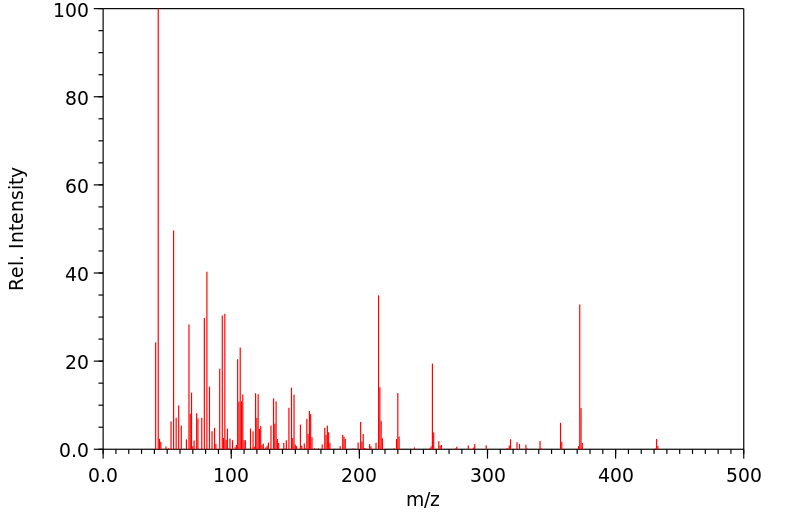(3β,5α,8α,9β,10α,13α,14β,17α,20S)-3-(acetyloxy)cholan-24-oic acid methyl ester | 960525-66-0
分子结构分类
中文名称
——
中文别名
——
英文名称
(3β,5α,8α,9β,10α,13α,14β,17α,20S)-3-(acetyloxy)cholan-24-oic acid methyl ester
英文别名
methyl (4S)-4-[(3S,5S,8S,9R,10R,13S,14R,17S)-3-acetyloxy-10,13-dimethyl-2,3,4,5,6,7,8,9,11,12,14,15,16,17-tetradecahydro-1H-cyclopenta[a]phenanthren-17-yl]pentanoate
CAS
960525-66-0
化学式
C27H44O4
mdl
——
分子量
432.644
InChiKey
DVIUCIPCTDVQAP-ACCPVXDNSA-N
BEILSTEIN
——
EINECS
——
-
物化性质
-
计算性质
-
ADMET
-
安全信息
-
SDS
-
制备方法与用途
-
上下游信息
-
文献信息
-
表征谱图
-
同类化合物
-
相关功能分类
-
相关结构分类
物化性质
-
熔点:127-129 °C(Solv: acetone (67-64-1); hexane (110-54-3))
-
沸点:487.5±18.0 °C(Predicted)
-
密度:1.06±0.1 g/cm3(Predicted)
计算性质
-
辛醇/水分配系数(LogP):7.2
-
重原子数:31
-
可旋转键数:7
-
环数:4.0
-
sp3杂化的碳原子比例:0.93
-
拓扑面积:52.6
-
氢给体数:0
-
氢受体数:4
反应信息
-
作为反应物:描述:(3β,5α,8α,9β,10α,13α,14β,17α,20S)-3-(acetyloxy)cholan-24-oic acid methyl ester 在 甲醇 、 4-二甲氨基吡啶 、 lithium aluminium tetrahydride 、 正丁基锂 、 sodium acetate 、 silica gel 、 三乙胺 、 乙酰氯 、 pyridinium chlorochromate 作用下, 以 四氢呋喃 、 乙醚 、 正己烷 、 二氯甲烷 为溶剂, 反应 1.25h, 生成 (3β,5α,8α,9β,10α,13α,14β,17α,20S)-3-[[(1,1-dimethylethyl)dimethylsilyl]oxy]cholest-24-ene参考文献:名称:Synthesis of the enantiomer of the oxysterol-antagonist LY295427摘要:Cellular cholesterol homeostasis is regulated by oxygenated cholesterol metabolites called oxysterols. While the importance of oxysterols in the acute regulation of cholesterol homeostasis is known, the precise molecular mechanisms through which oxysterols exert their effects remain to be elucidated. LY295427 (1) is a known antagonist of the cholesterol-homeostatic effects of 25-hydroxycholesterol (25-HC), a biologically active oxysterol. In order to examine the mechanism of action of this antagonism, and to further explore recent evidence suggesting that the membrane effects of 25-HC contribute to acute cholesterol regulation, we synthesized the enantiomer of LY295427 (ent-LY295427). ent-LY295427 (2) will serve as a unique probe to provide insight into the role of transcription-independent mechanisms in regulation of cholesterol homeostasis. Published by Elsevier Inc.DOI:10.1016/j.steroids.2011.03.008
-
作为产物:描述:(3β,5α,8α,9β,10α,13α,14β,20S,22E)-3-(acetyloxy)chola-16,22-dien-24-oic acid methyl ester 在 palladium on activated charcoal 氢气 作用下, 以 甲醇 为溶剂, 反应 2.0h, 以90%的产率得到(3β,5α,8α,9β,10α,13α,14β,17α,20S)-3-(acetyloxy)cholan-24-oic acid methyl ester参考文献:名称:Synthesis, Characterization, and Receptor Interaction Profiles of Enantiomeric Bile Acids摘要:Bile acids are endogenous steroid detergents with receptor-mediated physiologic actions including activation of the G-protein coupled receptor TGR5 and gene regulation mediated by nuclear receptors. In this study, we report the first synthesis of enantiomeric lithocholic acid (ent-LCA, ent-1) and chenodeoxycholic acid (ent-CDCA, ent-2) via ent-testosterone (3). ent-1 was synthesized in 21 total steps in 4.2% yield, whereas ent-2 was obtained in 23 total steps in 0.8% yield. Critical micelle concentrations of the enantiomeric bile acids were found to be identical to their natural counterparts. Furthermore, enantiomeric bile acids were also tested for their ability to modulate bile acid activated proteins: farnesoid X receptor, vitamin D receptor, pregnane X receptor, and TGR5. Interestingly, ent-1 and ent-2 showed differential interactions with these proteins as compared to their corresponding natural bile acids. These data highlight the potential for using enantioselectivity as away to distinguish between receptor and nonreceptor-mediated functions of natural bile acids.DOI:10.1021/jm0707931
表征谱图
-
氢谱1HNMR
-
质谱MS
-
碳谱13CNMR
-
红外IR
-
拉曼Raman
-
峰位数据
-
峰位匹配
-
表征信息
同类化合物
(5β)-17,20:20,21-双[亚甲基双(氧基)]孕烷-3-酮
(5α)-2′H-雄甾-2-烯并[3,2-c]吡唑-17-酮
(3β,20S)-4,4,20-三甲基-21-[[[三(异丙基)甲硅烷基]氧基]-孕烷-5-烯-3-醇-d6
(25S)-δ7-大发酸
(20R)-孕烯-4-烯-3,17,20-三醇
(11β,17β)-11-[4-({5-[(4,4,5,5,5-五氟戊基)磺酰基]戊基}氧基)苯基]雌二醇-1,3,5(10)-三烯-3,17-二醇
齐墩果酸衍生物1
黄麻属甙
黄芪皂苷III
黄芪皂苷 II
黄芪甲苷 IV
黄芪甲苷
黄肉楠碱
黄果茄甾醇
黄杨醇碱E
黄姜A
黄夹苷B
黄夹苷
黄夹次甙乙
黄夹次甙乙
黄夹次甙丙
黄体酮环20-(乙烯缩醛)
黄体酮杂质EPL
黄体酮杂质1
黄体酮杂质
黄体酮杂质
黄体酮EP杂质M
黄体酮EP杂质G(RRT≈2.53)
黄体酮EP杂质F
黄体酮6-半琥珀酸酯
黄体酮 17alpha-氢过氧化物
黄体酮 11-半琥珀酸酯
黄体酮
麦角甾醇葡萄糖苷
麦角甾醇氢琥珀酸盐
麦角甾烷-6-酮,2,3-环氧-22,23-二羟基-,(2b,3b,5a,22R,23R,24S)-(9CI)
麦角甾烷-3,6,8,15,16-五唑,28-[[2-O-(2,4-二-O-甲基-b-D-吡喃木糖基)-a-L-呋喃阿拉伯糖基]氧代]-,(3b,5a,6a,15b,16b,24x)-(9CI)
麦角甾烷-26-酸,5,6:24,25-二环氧-14,17,22-三羟基-1-羰基-,d-内酯,(5b,6b,14b,17a,22R,24S,25S)-(9CI)
麦角甾-8-烯-3-醇
麦角甾-8,24(28)-二烯-26-酸,7-羟基-4-甲基-3,11-二羰基-,(4a,5a,7b,25S)-
麦角甾-7,22-二烯-3-酮
麦角甾-7,22-二烯-17-醇-3-酮
麦角甾-5,24-二烯-26-酸,3-(b-D-吡喃葡萄糖氧基)-1,22,27-三羟基-,d-内酯,(1a,3b,22R)-
麦角甾-5,22,25-三烯-3-醇
麦角甾-4,6,8(14),22-四烯-3-酮
麦角甾-1,4-二烯-3-酮,7,24-二(乙酰氧基)-17,22-环氧-16,25-二羟基-,(7a,16b,22R)-(9CI)
麦角固醇
麦冬皂苷D
麦冬皂苷D
麦冬皂苷 B







